Monoblock Compaq Presario 3020
Quite by chance, I got into my hands a rather interesting candy bar Compaq Presario 3020 1996 release. Although the previous owner used it quite often, he treated it carefully, for which many thanks to him - in addition to the hard drive dying from time, all the other components, up to the CD-ROM drive, were in good condition, and their appearance was not overshadowed not a single serious scratch.
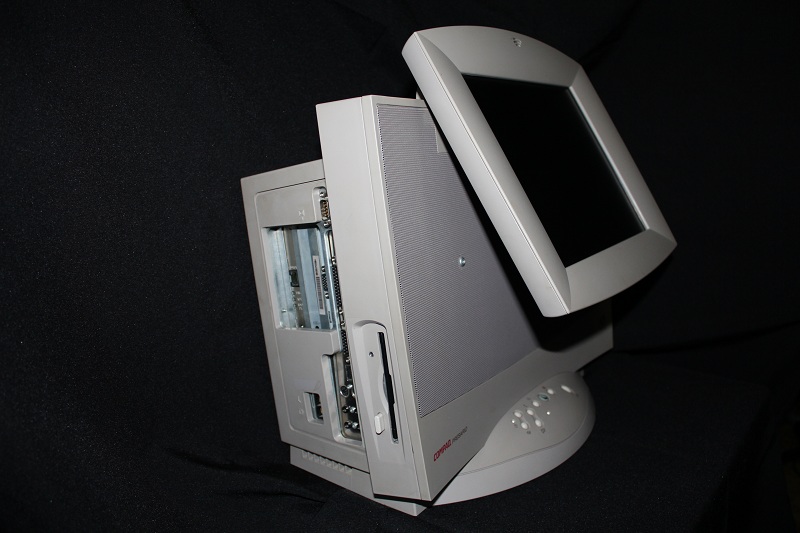
Lovers of antiquity, good for a favor under habrakat
(Caution - traffic)
Appearance.
Compaq Presario 3020 can be confused from a distance with a very ugly CRT monitor.

On the monoblock stand are buttons for adjusting the brightness and volume level, as well as a functional Q-button that provides additional features for the user, provided that the necessary software from Compaq is installed. The computer turns on and off with a button on the power supply on the back of the case. On the sides are built-in speakers. The tilt of the stand is not adjustable, but you can change the angle of the 12 "LCD display.

On the right side of the monoblock is a 6-speed NEC CD-ROM drive with a changer for four CDs. Yes, you were not mistaken, you can actually insert 4 CDs into the drive, it won’t even choke. Four CD-ROM readers will be available in the operating system at the same time, but, unfortunately, I have not tried to copy information from several disks at once. Most likely, this is impossible (and if possible, it is very slow and noisy - there is probably only one laser there).
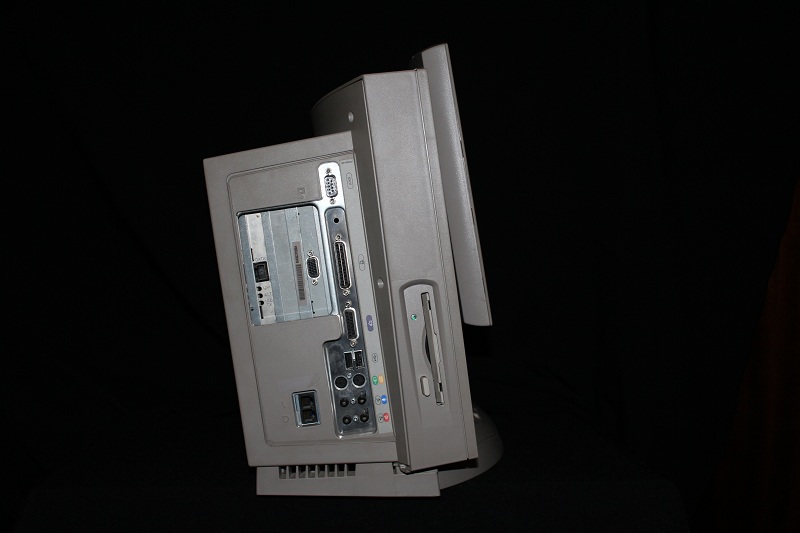
On the left side there is a drive for 3.5 inch floppy disks, COM and LPT ports, two RJ11 connectors of the internal ISA modem, two USB ports, keyboard and mouse interfaces PS / 2, as well as audio connectors of the built-in sound card ESS 1888. Compartment for installing cards there are only three extensions (two PCI slots and one ISA), but the S3 Aurora64V + video card is already installed in the first PCI slot, to the video output of which you can connect an additional VGA monitor. The video card supports a resolution of 800x600 (1024x768 when displaying an image on an additional monitor) and 32-bit color rendering.
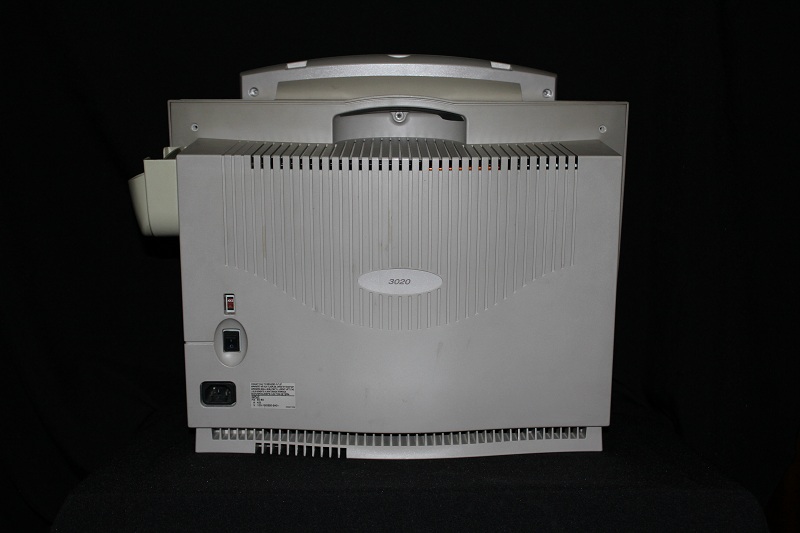
On the back of the case is a power connector and a computer power button.
Troubles
As it turned out, finding detailed technical information about the subject is quite difficult. Although you can download drivers and utilities for the Compaq Presario 3020 Desktop PC on the official website of the Hewlett-Packard company (which absorbed Compaq in 2001), you won’t be able to find a detailed manual - instead, it is suggested to download the service guide for laptops of the three thousandth series (and my experimental obviously not a laptop). It’s sad that the previous owner didn’t have the original paper instructions and disks from the Compaq Presario 3020, but the original cardboard box remained.
I had to confine myself to only brief information gleaned from QRG for the Presario 3000 Series PC .
Despite the lack of specificity, it can be assumed that the Compaq Presario 3020 has a Pentium I class processor with a clock frequency of up to 200 MHz and an
EDO SIMM RAM of no more than 128 MB.
But why guess at the coffee grounds, if you can just turn on the computer, go into the BIOS and see its characteristics?
So I did. However, the first trouble was waiting for me - the computer didn’t want to enter the BIOS by pressing F10, despite the fact that this is the standard way to get into the BIOS of Compaq computers before 2001.
After thoroughly reading the Internet, I found out that the BIOS of this computer “lies on his hard”. This, in part, is true - the graphical interface for setting up the basic I / O system is actually located in the service section on the hard drive, which, apparently, was overwritten by the previous owner.
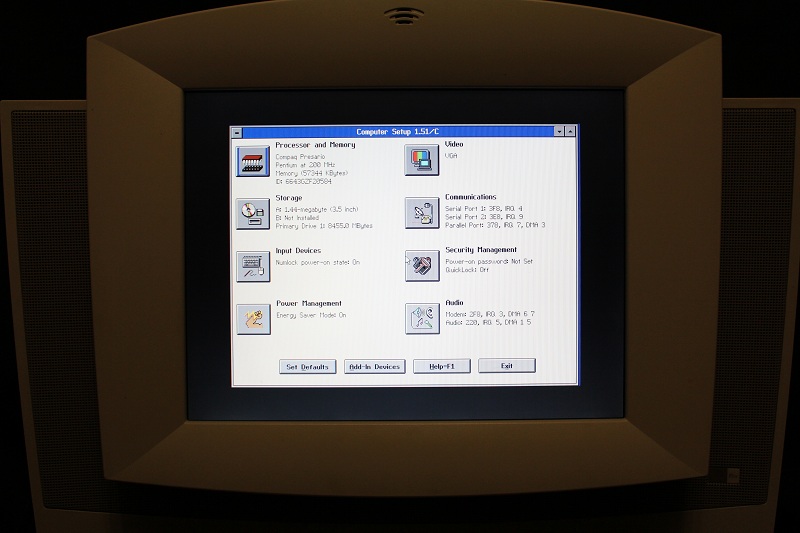
However, you can still change the BIOS settings without this section by booting from a diskette containing the proprietary Compaq Personal Computer Setup utility .
In order not to constantly boot from the floppy disk to change the settings, you must return to the place the service section containing the graphical BIOS interface and several diagnostic utilities. This can be done using two floppies - the first floppy should contain the Personal Computer Setup utilityand the second is Personal Computer Diagnostics . Images of these floppy disks can be downloaded on the official site of HP.
Boot from the first diskette and following the prompts of the wizard, we restore the service partition. The hard drive of the Compaq Presario 3020 computer should not be partitioned, otherwise it will fail.
That's it, the service section has been created! Now you can go into the BIOS setup graphical shell by waiting for the blinking white rectangle in the upper right corner of the screen and pressing F10 while the computer is loading.
The available BIOS version dates back to 1996, and was updated to the latest version using the Presario Specific Models System ROM Update Diskette .
Specifications.
Now you can see what is in the Compaq Presario 3020 under the “hood”:
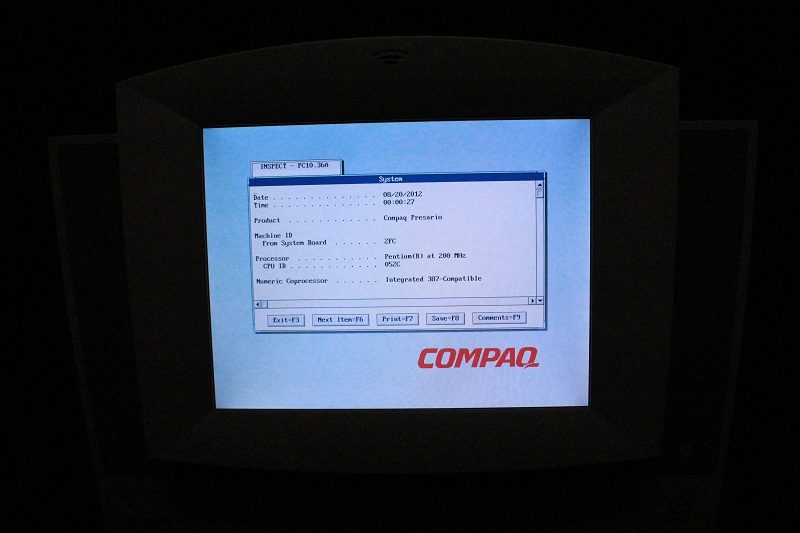
Due to the fact that the Compaq Presario 3020's native hard drive was slowly but surely dying of old age (making quite nasty sounds during operation), it was replaced found a more voluminous fellow, as much as as much as 20 GB. I did not install hard drives of a larger volume, since they have large starting and working currents, and I did not want to risk the health of the power supply at all.
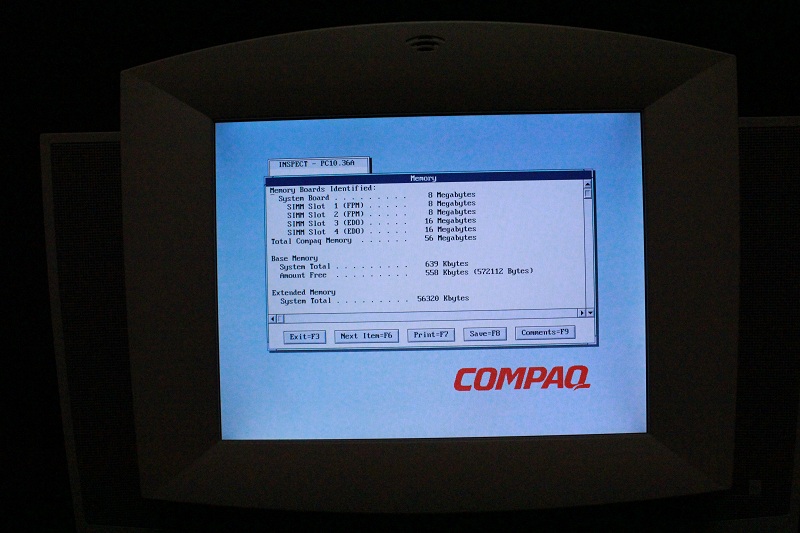
Naturally, the BIOS did not automatically see the full capacity of the new hard drive, and had to register its C / H / S geometry with pens. Immediately a second problem arose - the BIOS does not support hard drives larger than 8 GB. Well, we expose the 18383/16/63 geometry in the BIOS (which is exactly how IDE hard drives look like more than 8 GB), and we can safely rely on the primary boot partition for no more than eight gigabytes, which is enough for the correct installation of the operating system.
OS selection and installation
The choice of operating system for the Compaq Presario 3020 was carried out according to the following criteria: speed of operation, hardware support, and relevance of the version. But the most important parameter was the ability to run old DOS and later games, so * nix operating systems were considered for no more than 5 minutes.
Due to the lack of original driver disks, the installation of Windows NT 4.0 ended in complete failure - most devices, including a video card and sound, were not corny. The HP support site also did not find the necessary drivers, so the choice was the Windows 9x family.
Windows 95, although it requires less resources for its work, but compared to Windows 98 it is too old.
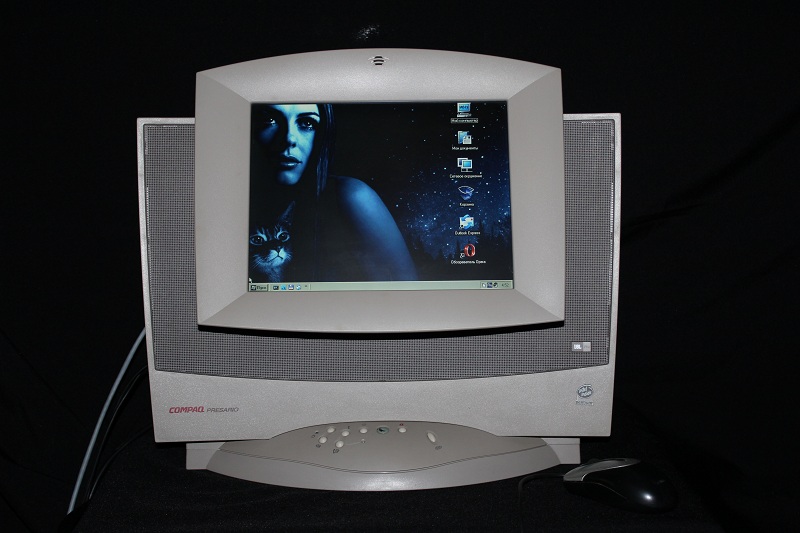
The choice fell on Windows 98, but not simple, but from Fedorenki. You can familiarize yourself with this assembly and its differences from regular Windows 98 in more detail on the author’s website .
It should be noted that if you make the primary boot partition larger than the amount that the BIOS sees, errors may occur when installing Windows 98 from under DOS, for example, read / write errors in the last sector of the disk.
That is, the installation of Windows 98 will not go beyond the stage of checking the Scandisk disk. Starting the OS installation without checking the disk will not solve the problem, so we will not tempt fate.
In addition, the remaining space can be marked out after installing the OS, and the maximum size of additional partitions will be limited only by the limitations of the file system into which they will be formatted. This is due to the fact that the Windows 98 operating system works great with large hard drives, despite the BIOS settings and limitations.
But everything was not as rosy as I wanted. After the hard drive with the created service partition was partitioned and formatted on another computer by PartitionMagic, the service partition got corrupted and the Compaq Presario 3020 stopped loading from it.
This depressing fact was enough to stop trying to format the hard drive on another computer. It was decided to create partitions on the Compaq Presario 3020 itself, but due to the small amount of RAM and the inability to boot from the CD-ROM (even the Plop Boot Manager did not help), I had to abandon PartitionMagic to use the most common FDISK.
The next nuisance - FDISK determined the total hard disk capacity to be 504 MB, although the BIOS explicitly indicates 8 GB. Apparently, this is due to the restriction of MS DOS on the permissible number of heads and the lack of support for translating CHS values in the Int 13h handler code in the BIOS.
To install Windows 98, this amount is enough, so I did not delve into the essence of the problem and simply created an active boot partition of 496 MB in size (the service partition ate 8 megabytes). Due to restrictions on the minimum size of the FAT32 file system partition, it was necessary to format the created partition in FAT16. An additional partition of a little less than 20 GB was created after installing the operating system.
At this stage, the ordeal with the installation of the operating system ended, and the fan started.
Opportunities
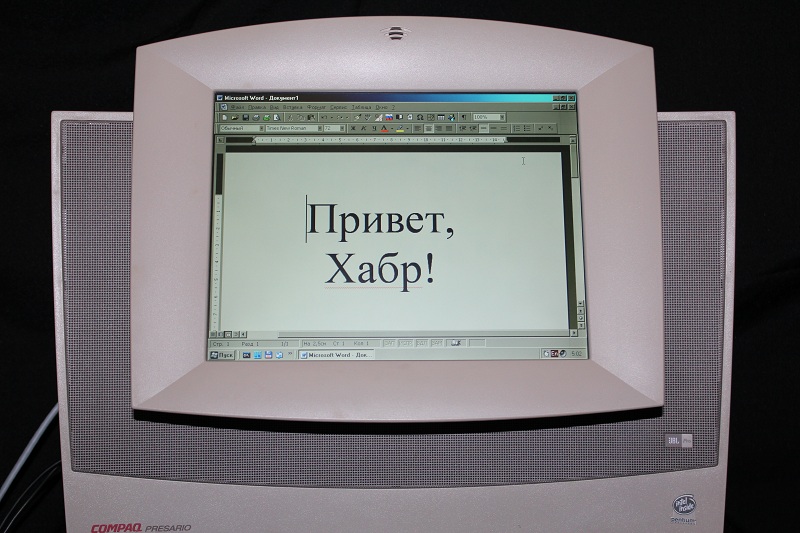
We start Microsoft Word 97
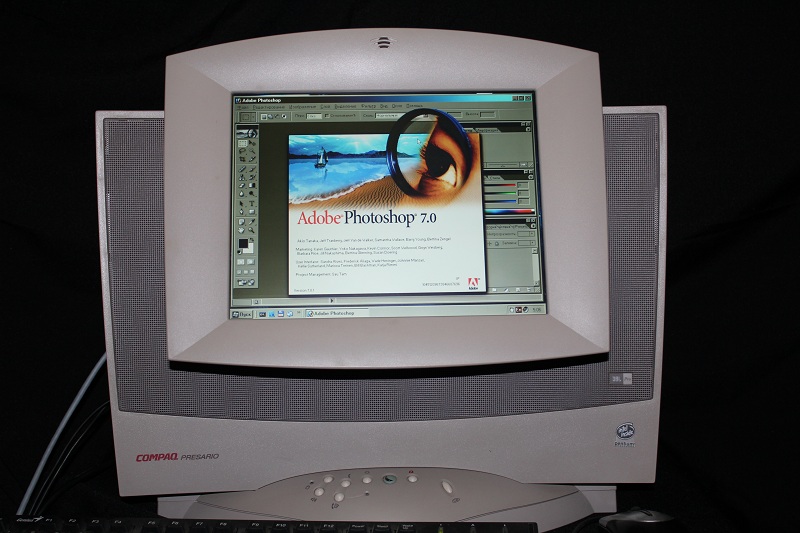
Photoshop 7
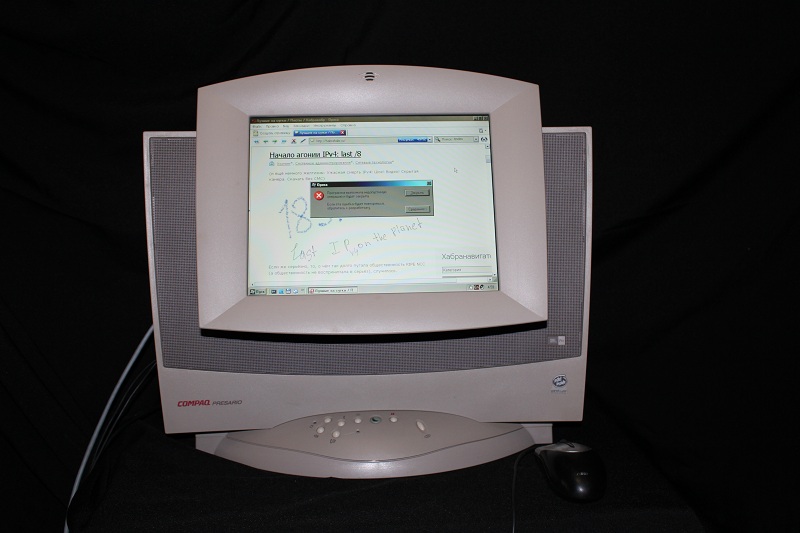
Internet also started (Opera broke, apparently, due to lack of memory)
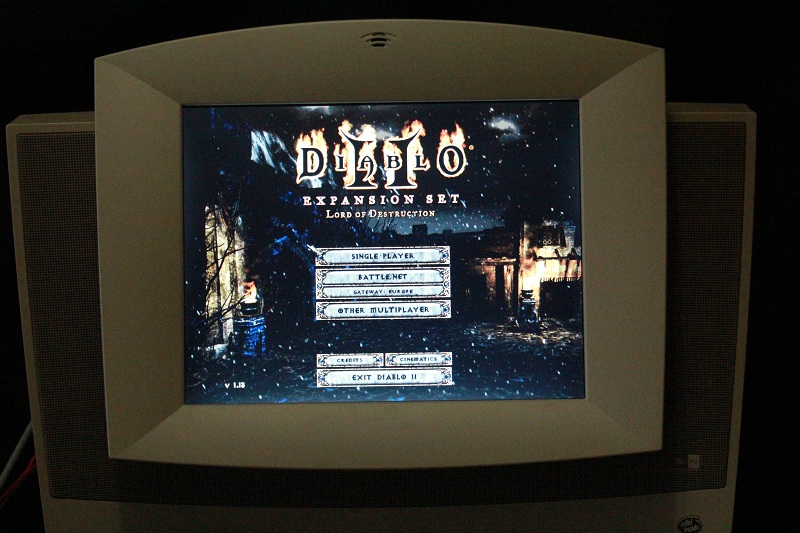
Well, of course, the game!
Fans of the old iron look have a surprise in the form of photos of the compaq Presario 3020 internals:

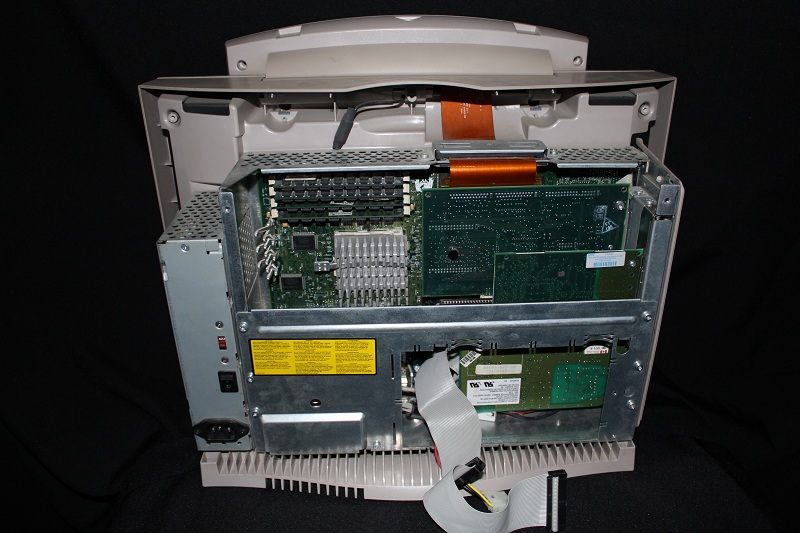
The back cover is removed
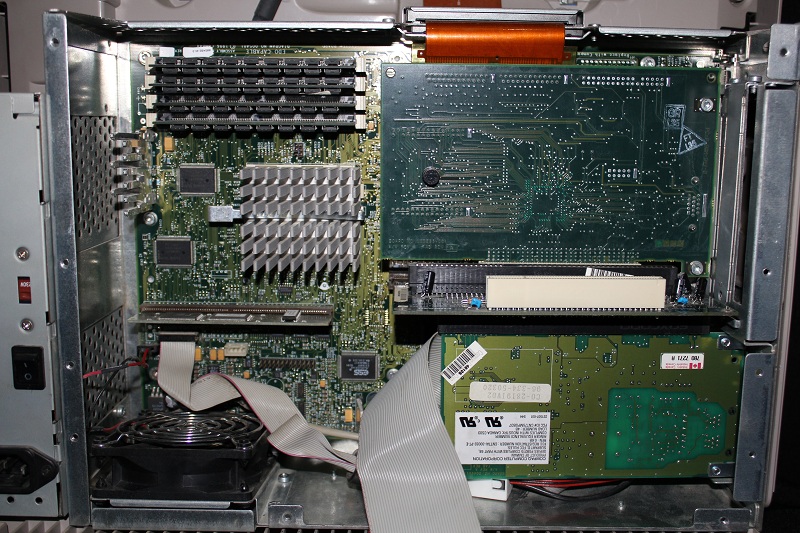
Inside

48 MB memory and 200 MHz Pentium I processor under passive cooling
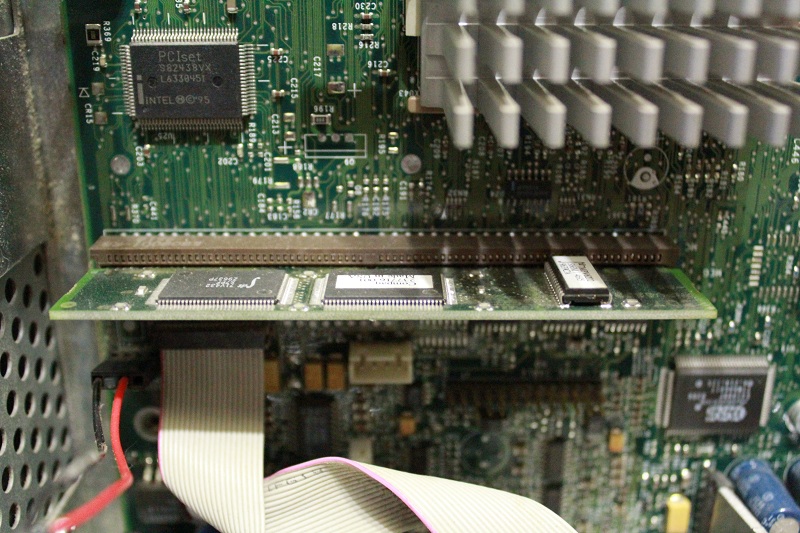
8 MB system memory
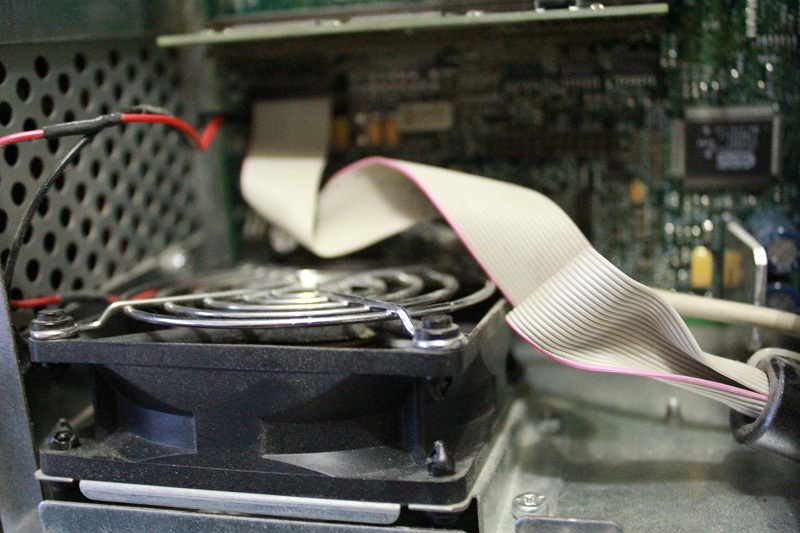
Fan located
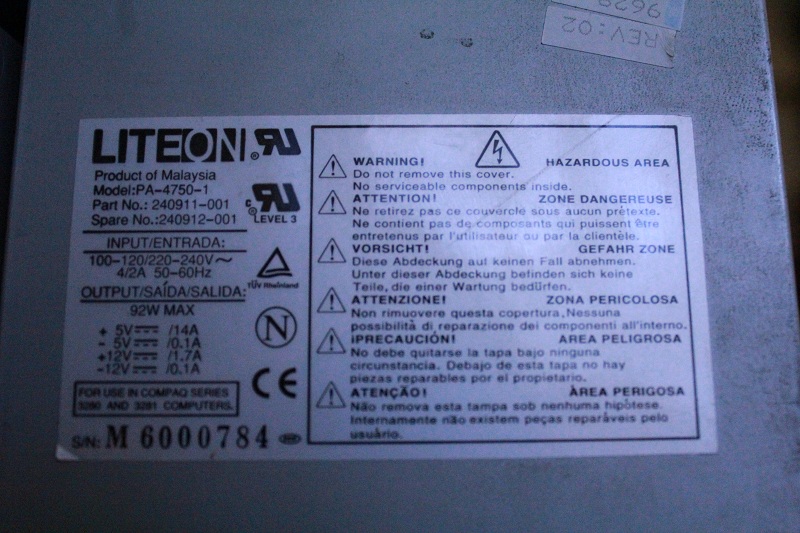
at the bottom of the case 92-watt power supply
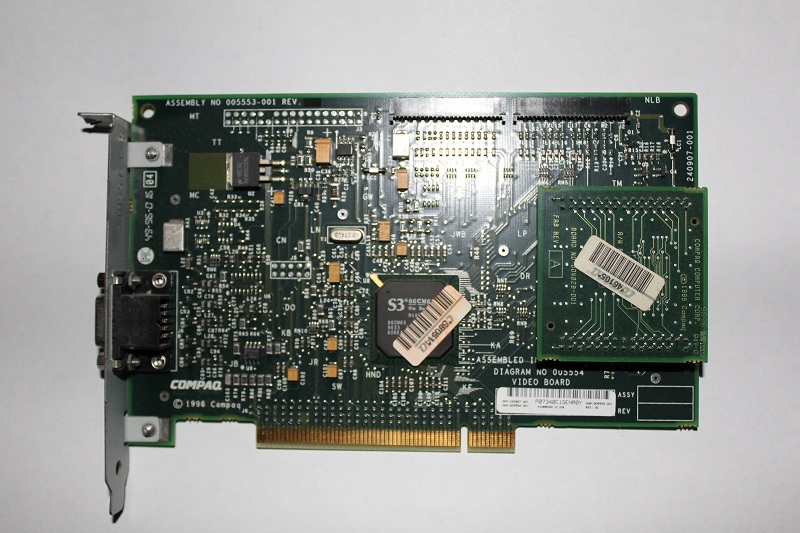

S3 Aurora64V + video card. Connects to the built-in LCD display using a special connector.
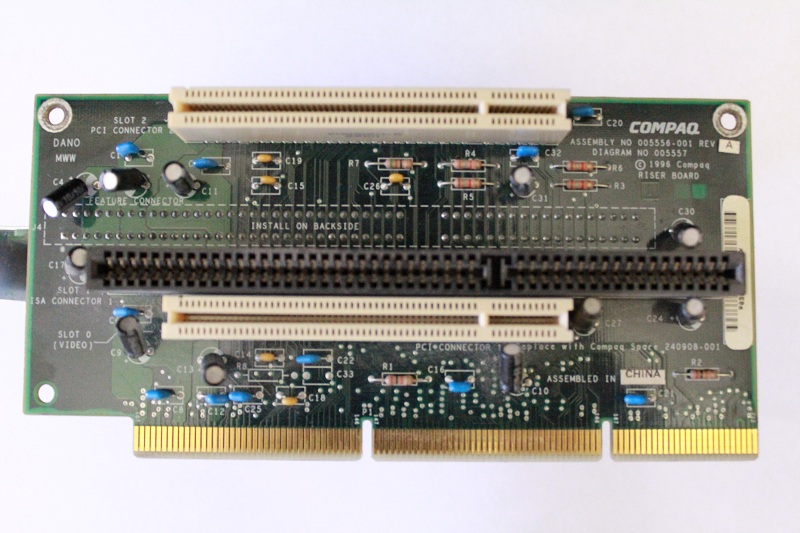
Herringbone for expansion cards three slots on top, one on the bottom.
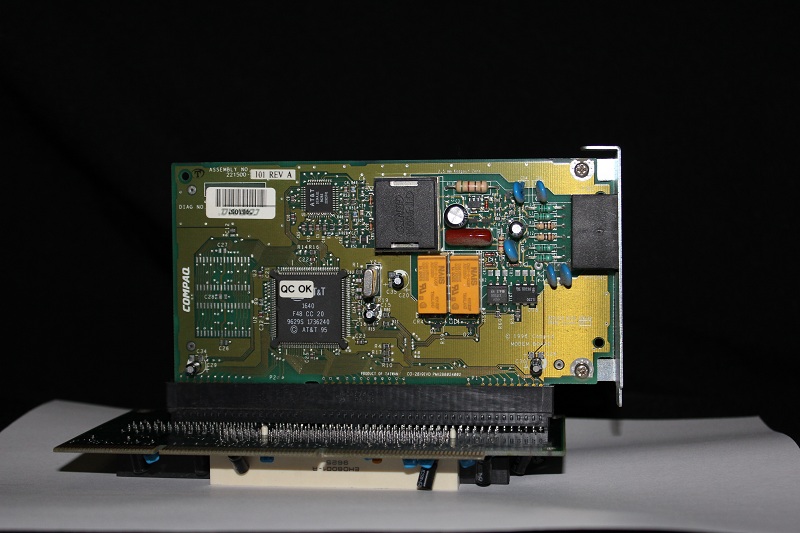
The Compaq Presario 33.6 internal modem is installed in the lower ISA slot.
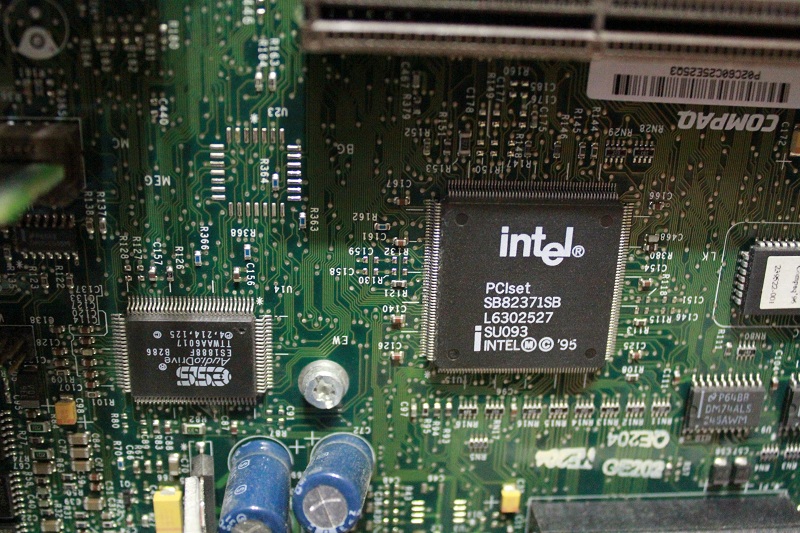
ESS 1888 Plug and Play AudioDrive Sound Card Chip
Summary
Compaq Presario 3020 will completely cope with the role of a typewriter, and will also be useful to fans of old games under DOS and Windows 95-98. The built-in modem allows you to use the computer as a fax, and the CD changer for 4 CDs and Winamp turns the candy bar into a simple music center.
And now…


Lovers of antiquity, good for a favor under habrakat
(Caution - traffic)
Appearance.
Compaq Presario 3020 can be confused from a distance with a very ugly CRT monitor.

On the monoblock stand are buttons for adjusting the brightness and volume level, as well as a functional Q-button that provides additional features for the user, provided that the necessary software from Compaq is installed. The computer turns on and off with a button on the power supply on the back of the case. On the sides are built-in speakers. The tilt of the stand is not adjustable, but you can change the angle of the 12 "LCD display.

On the right side of the monoblock is a 6-speed NEC CD-ROM drive with a changer for four CDs. Yes, you were not mistaken, you can actually insert 4 CDs into the drive, it won’t even choke. Four CD-ROM readers will be available in the operating system at the same time, but, unfortunately, I have not tried to copy information from several disks at once. Most likely, this is impossible (and if possible, it is very slow and noisy - there is probably only one laser there).

On the left side there is a drive for 3.5 inch floppy disks, COM and LPT ports, two RJ11 connectors of the internal ISA modem, two USB ports, keyboard and mouse interfaces PS / 2, as well as audio connectors of the built-in sound card ESS 1888. Compartment for installing cards there are only three extensions (two PCI slots and one ISA), but the S3 Aurora64V + video card is already installed in the first PCI slot, to the video output of which you can connect an additional VGA monitor. The video card supports a resolution of 800x600 (1024x768 when displaying an image on an additional monitor) and 32-bit color rendering.

On the back of the case is a power connector and a computer power button.
Troubles
As it turned out, finding detailed technical information about the subject is quite difficult. Although you can download drivers and utilities for the Compaq Presario 3020 Desktop PC on the official website of the Hewlett-Packard company (which absorbed Compaq in 2001), you won’t be able to find a detailed manual - instead, it is suggested to download the service guide for laptops of the three thousandth series (and my experimental obviously not a laptop). It’s sad that the previous owner didn’t have the original paper instructions and disks from the Compaq Presario 3020, but the original cardboard box remained.
I had to confine myself to only brief information gleaned from QRG for the Presario 3000 Series PC .
Despite the lack of specificity, it can be assumed that the Compaq Presario 3020 has a Pentium I class processor with a clock frequency of up to 200 MHz and an
EDO SIMM RAM of no more than 128 MB.
But why guess at the coffee grounds, if you can just turn on the computer, go into the BIOS and see its characteristics?
So I did. However, the first trouble was waiting for me - the computer didn’t want to enter the BIOS by pressing F10, despite the fact that this is the standard way to get into the BIOS of Compaq computers before 2001.
After thoroughly reading the Internet, I found out that the BIOS of this computer “lies on his hard”. This, in part, is true - the graphical interface for setting up the basic I / O system is actually located in the service section on the hard drive, which, apparently, was overwritten by the previous owner.

However, you can still change the BIOS settings without this section by booting from a diskette containing the proprietary Compaq Personal Computer Setup utility .
In order not to constantly boot from the floppy disk to change the settings, you must return to the place the service section containing the graphical BIOS interface and several diagnostic utilities. This can be done using two floppies - the first floppy should contain the Personal Computer Setup utilityand the second is Personal Computer Diagnostics . Images of these floppy disks can be downloaded on the official site of HP.
Boot from the first diskette and following the prompts of the wizard, we restore the service partition. The hard drive of the Compaq Presario 3020 computer should not be partitioned, otherwise it will fail.
That's it, the service section has been created! Now you can go into the BIOS setup graphical shell by waiting for the blinking white rectangle in the upper right corner of the screen and pressing F10 while the computer is loading.
The available BIOS version dates back to 1996, and was updated to the latest version using the Presario Specific Models System ROM Update Diskette .
Specifications.
Now you can see what is in the Compaq Presario 3020 under the “hood”:

Due to the fact that the Compaq Presario 3020's native hard drive was slowly but surely dying of old age (making quite nasty sounds during operation), it was replaced found a more voluminous fellow, as much as as much as 20 GB. I did not install hard drives of a larger volume, since they have large starting and working currents, and I did not want to risk the health of the power supply at all.

Naturally, the BIOS did not automatically see the full capacity of the new hard drive, and had to register its C / H / S geometry with pens. Immediately a second problem arose - the BIOS does not support hard drives larger than 8 GB. Well, we expose the 18383/16/63 geometry in the BIOS (which is exactly how IDE hard drives look like more than 8 GB), and we can safely rely on the primary boot partition for no more than eight gigabytes, which is enough for the correct installation of the operating system.
OS selection and installation
The choice of operating system for the Compaq Presario 3020 was carried out according to the following criteria: speed of operation, hardware support, and relevance of the version. But the most important parameter was the ability to run old DOS and later games, so * nix operating systems were considered for no more than 5 minutes.
Due to the lack of original driver disks, the installation of Windows NT 4.0 ended in complete failure - most devices, including a video card and sound, were not corny. The HP support site also did not find the necessary drivers, so the choice was the Windows 9x family.
Windows 95, although it requires less resources for its work, but compared to Windows 98 it is too old.

The choice fell on Windows 98, but not simple, but from Fedorenki. You can familiarize yourself with this assembly and its differences from regular Windows 98 in more detail on the author’s website .
It should be noted that if you make the primary boot partition larger than the amount that the BIOS sees, errors may occur when installing Windows 98 from under DOS, for example, read / write errors in the last sector of the disk.
That is, the installation of Windows 98 will not go beyond the stage of checking the Scandisk disk. Starting the OS installation without checking the disk will not solve the problem, so we will not tempt fate.
In addition, the remaining space can be marked out after installing the OS, and the maximum size of additional partitions will be limited only by the limitations of the file system into which they will be formatted. This is due to the fact that the Windows 98 operating system works great with large hard drives, despite the BIOS settings and limitations.
But everything was not as rosy as I wanted. After the hard drive with the created service partition was partitioned and formatted on another computer by PartitionMagic, the service partition got corrupted and the Compaq Presario 3020 stopped loading from it.
This depressing fact was enough to stop trying to format the hard drive on another computer. It was decided to create partitions on the Compaq Presario 3020 itself, but due to the small amount of RAM and the inability to boot from the CD-ROM (even the Plop Boot Manager did not help), I had to abandon PartitionMagic to use the most common FDISK.
The next nuisance - FDISK determined the total hard disk capacity to be 504 MB, although the BIOS explicitly indicates 8 GB. Apparently, this is due to the restriction of MS DOS on the permissible number of heads and the lack of support for translating CHS values in the Int 13h handler code in the BIOS.
To install Windows 98, this amount is enough, so I did not delve into the essence of the problem and simply created an active boot partition of 496 MB in size (the service partition ate 8 megabytes). Due to restrictions on the minimum size of the FAT32 file system partition, it was necessary to format the created partition in FAT16. An additional partition of a little less than 20 GB was created after installing the operating system.
At this stage, the ordeal with the installation of the operating system ended, and the fan started.
Opportunities

We start Microsoft Word 97

Photoshop 7

Internet also started (Opera broke, apparently, due to lack of memory)

Well, of course, the game!
Fans of the old iron look have a surprise in the form of photos of the compaq Presario 3020 internals:


The back cover is removed

Inside

48 MB memory and 200 MHz Pentium I processor under passive cooling

8 MB system memory

Fan located

at the bottom of the case 92-watt power supply


S3 Aurora64V + video card. Connects to the built-in LCD display using a special connector.

Herringbone for expansion cards three slots on top, one on the bottom.

The Compaq Presario 33.6 internal modem is installed in the lower ISA slot.

ESS 1888 Plug and Play AudioDrive Sound Card Chip
Summary
Compaq Presario 3020 will completely cope with the role of a typewriter, and will also be useful to fans of old games under DOS and Windows 95-98. The built-in modem allows you to use the computer as a fax, and the CD changer for 4 CDs and Winamp turns the candy bar into a simple music center.
And now…

